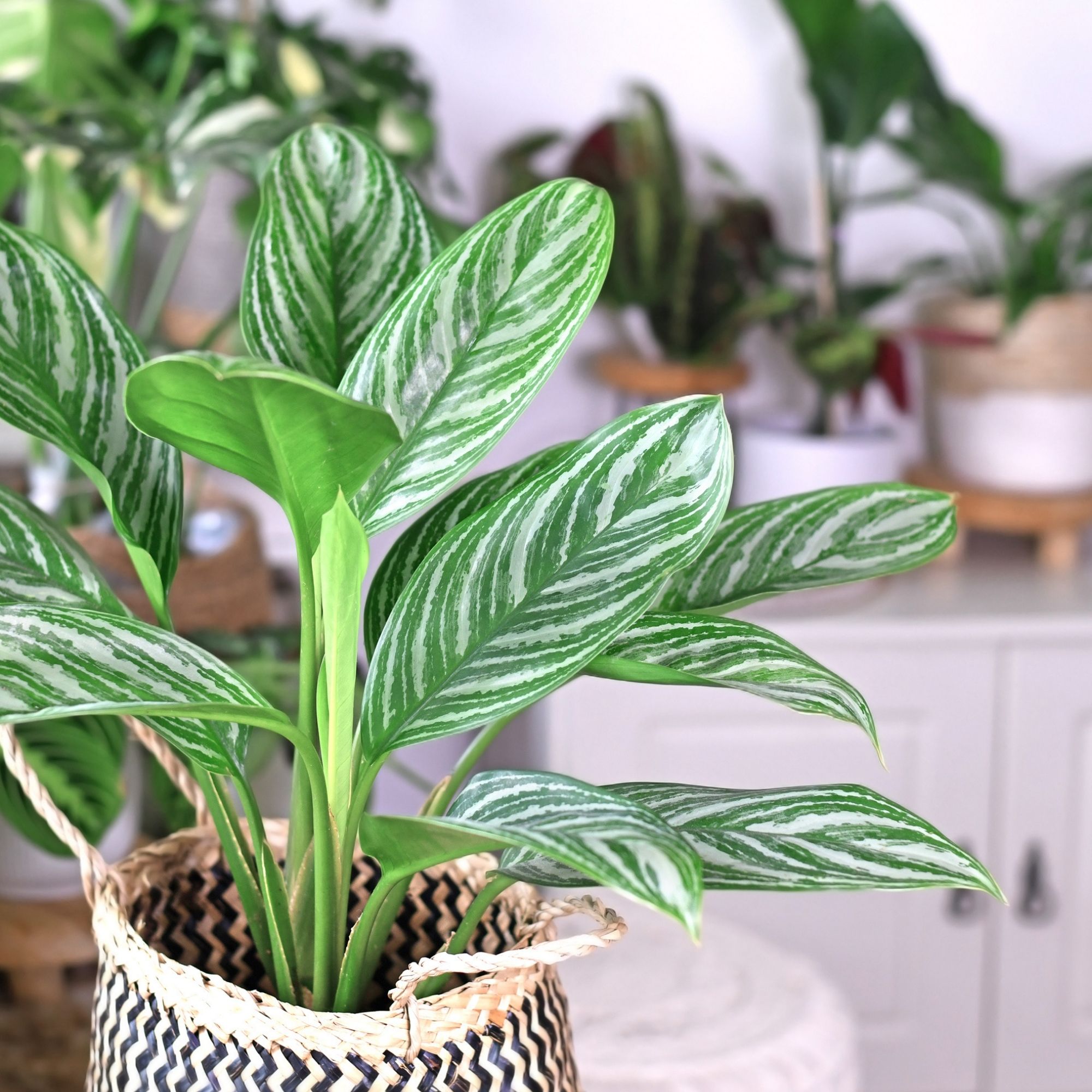Best plants for condensation and damp – 7 moisture-absorbing plants that control humidity
Top options for moisture control, from areca palms to peace lilies

Sophie King

Curious about the best plants for condensation and damp? If, like us, you're battling against excess moisture in your home now that temperatures have fallen, you might want to consider adding a few houseplants to your arsenal.
That's right – there's a host of moisture-absorbing plants out there that could help you tackle dampness in your home. And while investing in one of the best dehumidifiers is one of the most effective ways to get rid of damp in your home, houseplants can play an unexpected role, too.
So, we've asked plant experts for their take on the best plants for condensation and damp...
Best houseplants for reducing condensation and damp
Wondering about the science behind moisture-absorbing plants? Well, condensation on windows or damp walls is caused by excess indoor humidity, and since some plants absorb moisture from the air, they can be used as a natural way to combat this.
'Some plants can help you reduce the humidity in your home by absorbing moisture from the air, especially during the cold season,' explains Shannen Godwin, gardening expert at J Parker's. 'Place these plants in areas where condensation is likely to occur, such as near windows or walls.'
So, what are the best plants for condensation and damp? We spoke to plant experts and rounded up their top recommendations.
1. Areca palm

We recently celebrated areca palms as fantastic houseplant Christmas tree alternatives if you're looking for a tropical twist on the festive season, but according to houseplant experts, they're also one of the best plants for condensation and damp.
Sign up to our newsletter for style inspiration, real homes, project and garden advice and shopping know-how
'This indoor palm is great for moisture regulation,' says Andy Little, houseplant buyer at British Garden Centres. 'It can absorb and release moisture into the air, making it ideal for the home.'
Areca palms love humidity, so placing them in a spot that's prone to damp will help them thrive, too.
Where to buy an areca palm:
- Primrose: Buy Dypsis Lutescens in a range of sizes
- Gardening Express: Another Dypsis areca palm to help absorb moisture
2. Spider plant

This popular houseplant, with its long white and green tendrils, is not only one of the best plants for the bedroom but also one of the easiest to look after.
Mark Lane, Stannah's gardening expert and BBC Gardeners’ World presenter, explains that they are particularly efficient at eliminating damp, too. 'Spider plants are excellent for absorbing excess moisture and improving indoor air quality,' he says. 'They are also easy to care for and adapt well to different conditions.'
So, if you’re new to houseplants, this could be a great place to start! If you already have a spider plant, you could try growing spider plant babies so you can dot them around other rooms that might need moisture control.
Where to buy a spider plant:
- Amazon: Buy the traditional-looking Chlorophytum 'Bonnie Trailing' spider plant
- Gardening Express: Opt for the unique orange-hued leaves of Chlorophytum 'Fire Flash'
3. Chinese evergreen

Chinese evergreens are another brilliant choice if you're looking for unkillable houseplants that control moisture levels.
'Chinese evergreens, also known as Aglaonema, are effective at reducing humidity levels, making them a great choice for homes where condensation is a concern,' Mark says.
Not only is the Chinese evergreen plant easy to grow and good for reducing humidity levels, but it’s also one of the best plants for limiting toxins in your home. It’s said to be excellent at cleansing your home of things like formaldehyde for example, which is often emitted from furniture or sofas.
Where to buy a Chinese evergreen plant:
- Amazon: Start small with this baby Chinese evergreen plant, which boasts red, white and green foliage
- Crocus: Go for the elegant foliage of Aglaonema 'Jubilee Compacta'
4. Peace lily

There are a myriad of benefits to owning a peace lily plant, not least the pretty white flowers they produce. But, Mark says, they’re also ideal for promoting a healthier environment in your home, and they're another great example of moisture-absorbing plants.
'Otherwise known as Spathiphyllum, peace lilies are known for their air-purifying qualities and can effectively reduce humidity by releasing moisture through their leaves,' says Mark. 'They're also very visually appealing.'
Andy agrees, 'Peace lilies thrive in humid environments, making them ideal for the home, and they can absorb mould spores, helping to prevent their spread.'
If you’re keen to pick one up, it’s worth bearing a few things in mind in order to care for a peace lily properly. 'They prefer indirect light and moist soil, but be careful not to overwater them,' Shannen warns. 'They are also toxic to pets, so keep them out of reach.'
Where to buy a peace lily:
- Flying Flowers: Add the Serene Peace Lily to your houseplant collection
- Bloom & Wild: Another brilliant place to adopt a peace lily plant
5. Aloe vera

Aloe vera has long been popular as a medicinal plant, with its gel often used for cuts, scrapes or burns. However, it can be just as good an option for your home as it is for your health, Shannen says. 'Aloe vera is a succulent plant that can absorb moisture and reduce humidity in your home,' she explains.
When it comes to learning how to care for aloe vera, or how to propagate an aloe vera plant properly, there are a few factors to consider. 'It needs bright light and well-drained soil, but water it sparingly,' Shannen advises. 'It is also safe for pets and humans.'
Where to buy an aloe vera plant:
- Amazon: Add an aloe vera plant to your collection of indoor plants
- Plants For All Seasons: Another great place to buy the popular aloe vera plant
6. Boston fern

Boston ferns are famed for their lush, green leaves, but Millie Durbak of Prestige Flowers says that that's not all they’re good for, revealing that they can effectively eliminate moisture in the air, too.
'Boston ferns thrive in warm and moist environments, so they're great for bathrooms, with the added bonus of looking great,' she says. 'For the best results, you will probably need more than one, though.'
For nervous or novice plant owners, Morris Hankinson, founder and managing director at Hopes Grove Nurseries, also reassures us that these moisture-absorbing plants are a solid option.
'The Boston fern (or Nephrolepsis) is another classic houseplant that is undemanding in terms of both maintenance and the amount of sunlight required,' he says.
Where to buy a Boston fern:
- B&Q: Buy Nephrolepis Boston fern for moisture control
- M&S: This Boston fern comes in a ceramic pot
7. Snake plant

Finally, the much-loved snake plant also makes our list of the best plants for condensation and damp.
'They can absorb moisture and remove harmful chemicals from the air, which is fantastic,' Shannen says.
Millie agrees, saying that they should thrive in areas like the bathroom, too, if you're wondering how to care for a snake plant. 'Snake plants, also known as mother-in-law’s tongue, also survive well in humid environments, making them a good choice if you want to try them out.'
And that’s not all; Millie says that they 'are also hardy and require very little maintenance,' making them another win-win option for new plant owners.
Where to buy a snake plant:
- Waitrose Garden: Buy the variegated Sansevieria trifasciata var. laurentii snake plant
- The Range: A 70-80cm Sansevieria Laurenti snake plant for a larger space
FAQs
Can plants act as dehumidifiers?
The debate around whether or not houseplants can act as dehumidifiers is a divisive one. Generally, the theory is that plants which love humidity are more likely to absorb moisture.
Certain plants should be avoided, though – in fact, some plants can actually increase moisture in the home.
'Plants transpire and release water through their leaves,' says Tiffany Dent, an experienced Wecandoo artisan and founder of The Archway Planter. 'As an example, you can think of a closed terrarium and how the glass tends to mist up, or the humidity felt in a greenhouse – plants are more likely to increase humidity.
'However, there are plants that certainly thrive better in a humid environment since they absorb moisture through their leaves, like any ferns such as Boston ferns, staghorn ferns or Aspleniums. Peace lilies, Calathea and spider plants will also do well. Plants with thin, delicate leaves tend to like higher humidity.'
Which plant absorbs the most moisture?
The peace lily and Boston fern are two of the best plants for absorbing moisture in the air. However, a surprise small plant for removing excess moisture is an air plant, or Tillandsia. These little plants don't live in soil because they draw moisture from the air instead.
While we wouldn't recommend popping one in your bathroom to help with condensation, it could help in other rooms in the house to help minimise moisture.
Do remember that houseplants can only help ease a humidity problem in your home. If you are tackling a serious damp problem, invest in a dehumidifier and speak to professional to get it sorted as soon as possible.

Amy Hunt is an experienced digital journalist and editor, now working in a freelance capacity specialising in homes and interiors, wellness, travel and careers. She was previously Lifestyle Editor at woman&home, overseeing the homes, books and features sections of the website. Having worked in the industry for over eight years, she has contributed to a range of publications including Ideal Home, Livingetc, T3,Goodto, Woman, Woman’s Own, and Red magazine.
- Sophie KingGardens Editor